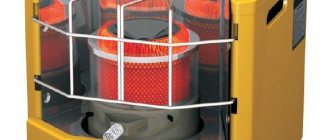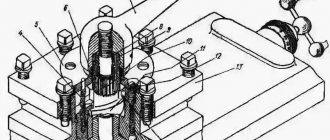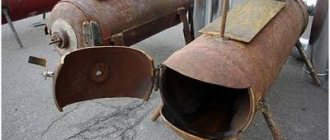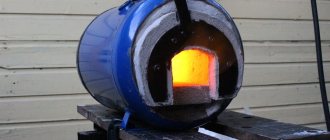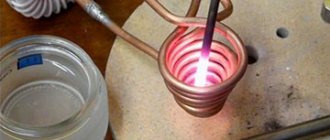Author: Yuriy Fedorovich Kolesnikov, thermal power engineer
Diesel fuel (solar oil, diesel fuel, diesel fuel; simply diesel) has a high calorific value to cost ratio and transportability, and in terms of fire hazard it is closer to vegetable oils and heavy petroleum products than to light ones. Therefore, diesel fuel stoves are widely used wherever there is no local fuel or opportunities for its procurement. Another advantage of a diesel stove (diesel stove) is that it quickly reaches full speed without supercharging. In fact, a diesel stove is the only energy-independent means to quickly warm up an uninsulated, very cold room.
Industrial diesel fuel furnaces
However, making a fairly safe diesel stove with your own hands requires much more care and deeper knowledge of the matter than using heavy liquid fuel, for example, during testing. In terms of volatility (evaporation), diesel fuel is still closer to light petroleum products. Under no circumstances should you burn diesel in a pressure-free burner (simply in a bath) with the air supply regulated by a throttle, like oil: the fuel may boil over the entire mass and result in an explosion.
The authors of popular RuNet guides on this topic seem to be more knowledgeable about copying from each other than about heating engineering. The absurdity of the errors reaches a kind of “medical burner” (???). It is possible (but not necessary) to make a feeding reservoir for a furnace with a dropper from a medical heating pad. But if anyone knows what a “medical burner” is, it’s not doctors. This article describes what is possible and how to properly make a diesel fuel stove with your own hands.
Note: non-volatile stoves that can quickly reach maximum mode and heat uninsulated rooms are most often called miracle stoves. Another meaning of the name miracle stove is multi-fuel, incl. on solid, liquid fuel and gas. Another one is an autonomous furnace using diesel fuel, waste fuel and, possibly, kerosene. In this publication, depending on the context, it is possible to use the term “miracle oven” in any of the indicated senses.
Design of heating equipment running on diesel fuel
A factory or homemade diesel garage heater is multifunctional equipment.
It can be used as the main, additional or alternative source of thermal energy if there is a heating system already installed in the room. If necessary, the stove can be used as a hob: food can be quickly heated on it and the kettle can boil.
Important! Diesel heaters are strictly prohibited from being installed in poorly ventilated areas. And if during operation the stove almost does not emit harmful substances into the atmosphere, then during ignition and extinguishing the fire, emissions of a small amount of compounds hazardous to human health are observed in the smoke
Many models of diesel stoves can operate not only on DP, but also on other types of liquid fuel. Judging by reviews from consumers and some experts, the best option in this case is kerosene. But due to a huge desire to save money, people prefer diesel fuel.
For reference! Diesel stoves are very economical: based on practice, one tank refill is enough for continuous operation of the heater for 6-28 hours. Take-off time is regulated by the design of the model and the volume of the fuel tank.
The operating principle of a heat gun.
Heaters of this type consist of a fuel tank - in most cases it is removable, equipped with a valve, a replaceable block with a wick, an adjusting screw, a reflector and the burner itself. All structural elements are located in a common housing.
If we are talking about homemade equipment, then a barrel, a tank welded from sheets of heat-resistant steel, or even a used gas cylinder will work as a body.
The burner is placed in the center of the structure. Fuel is supplied to it from a tank located at the rear wall of the device body. In order to achieve the required temperature, an adjustment screw is used. And due to the reflector included in the design, quick and reliable heating of the room is ensured.
If you plan to purchase a factory heater, then it is better to give preference to compact models weighing 10-20 kg. Such equipment, if necessary, can be easily moved to another location using your own resources.
Ignition
It is better to ignite outdoors, and only then bring the working device into the house (this will avoid unpleasant odors in the room).
If the stove has not been used for a long time, it must be cleaned before starting ignition. The grate, burner, tank on the rear wall are removed, and the entire fuel unit is pulled out. All parts are cleaned, the reflector screen is rubbed.
It is very important to install the device strictly horizontally, otherwise it will be difficult to achieve uniform burning of the wick along its entire length. Then ignition:. Then ignition:
Then ignition:
- Fuel is poured into the removable tank.
- A new wick is installed in the burner (twisted into a ring at the bottom of the burner).
- The burner and grate return to their original place.
- The valve unscrews slightly, which allows fuel to access the wick.
- The front panel opens and acts as a door.
- The edge of the rolled paper is lit and brought to the burner from below.
- When the fuel burns well and the flame rises above the grate, the valve closes completely (the red-hot bottom of the burner will indicate that sufficient heating has occurred).
- After waiting until the flame begins to go out, turn it off again, but this time to the intensity that you would like to achieve.
When you need to turn off the stove, turn the valve all the way.
While the user has little experience in handling the stove, it is very difficult to achieve even burning of the wick (this can take more than half an hour).
But if you have experience igniting, but still cannot get a blue flame throughout the entire wick, this may be one of the following problems:
- Uneven surface, tilt of the oven.
- The burner cylinder has not yet warmed up completely.
- The wick is worn out (it burns slightly every time and the more it is used, the more damaged it becomes).
You can try to extend the life of a worn wick by simply turning it over, or trimming the burnt edge with scissors. To make the wick last longer, it can be periodically washed in kerosene.
Pyrolysis oven
A pyrolysis stove is a heating device that consists of two consecutive combustion chambers. In the first section, fuel (wood, coal, etc.) smolders, releasing pyrolysis gas, which, under the influence of forced or natural draft, enters the second chamber, where it mixes with oxygen. The efficiency of this heating device is 90-95%. Pellets, dry firewood, branches, sawdust and other wood residues are used as fuel.
Scheme of operation of a pyrolysis furnace
A pyrolysis stove heats the room by heating the walls of the stove. To increase heat transfer, craftsmen lay fireclay bricks inside the furnace and refractory bricks outside. Technology for creating a pyrolysis stove with your own hands:
- Using welding, a stove body with openings for the firebox and ash pan is formed from a sheet of steel. A grate (grid made of reinforcement) is installed between the combustion chamber and the place for the ash.
- The combustion chamber is located above the firebox; they are separated from each other by a steel plate.
- In the upper section there is a damper for air supply.
- The body is covered with bricks.
- A heat-insulated chimney pipe is installed on top of the stove.
If desired, a pyrolysis potbelly stove can be coated with heat-resistant paint. Such a heating device will fit perfectly into the interior of a country house, garage or utility room.
Manufacturing instructions
There are many instructions on the Internet that describe the manufacturing procedure in detail. But such a stove comes in a variety of types, each of them has its own advantages and disadvantages, so an ignorant person often finds it difficult to choose the appropriate option
Also, when choosing a particular model, you need to take into account the conditions of future operation.
Drip furnace
Drip furnace
The most optimal option for use at home. Manufacturing does not require much time, and the finished structure will take only a few square meters of space (if we talk about the largest option). But in most cases it is made portable, which is why it is very popular among tourists for heating tents.
The manufacturing technology of the drip structure is as follows.
First stage. First, take a medical burner (its capacity usually does not exceed two liters).
Second phase. The burner is equipped with a rubber hose with a copper tube of the appropriate diameter connected to it, after which the tube is bent at an angle of 90°C.
Third stage. Then the hose should be bent in half.
Fourth stage. Take a clamp equipped with a screw and attach it to the bend.
If a larger drip furnace is needed, then sheet metal must be used for manufacturing. In this case, the structure will consist of a pair of parts that fit into each other and will be located away from the front door. It must be remembered that the operating principle of such structures is based on the periodic supply of diesel fuel to the fuel tank. This allows the construction of furnaces of various sizes and shapes.
Two-tank stove
Two-tank stove
There is another equally popular manufacturing method, based on the use of several tanks connected to each other by perforated (that is, with numerous holes) pipes. In this case, the lower reservoir serves not only as a fuel tank, but also as a combustion chamber. The capacity of this design is impressive - about 12 liters. For the manufacture of the case, steel sheets with a thickness of 3 mm to 5 mm are used, which prevents the walls from burning through and, therefore, increases the service life of the device.
Two-tank stove
A hole is made in the upper tank with a closing lid. A pipe is welded to the bottom of the housing, onto which the exhaust pipe is installed. To make this pipe, it is necessary to use only galvanized steel, since the temperature of this element during operation can reach 250ᵒC. If the room in which the stove is installed has a small area, then it is advisable to make the upper part of the structure removable for more convenient cleaning.
Stove made of metal sheets
Briefly, it looks like two large cans or disks connected by a pipe with many holes and a combustion pipe at the top. The device consists of two containers connected by a large diameter pipe (wick bowl) with rows of holes for air intake and smoke exhaust.
Kerosene or diesel fuel from the fuel chamber enters the wick container by gravity. There the fuel is heated and a gaseous mixture is obtained. It goes into the combustion chamber and burns there. A spiral is placed in its upper part, it acts as a heating element and heats up to 800°C, combustion waste is removed through the chimney.
A home-made device can be compact in size and has a high level of safety. It is very economical: the fuel mixture and flammable compounds burn completely. You will need metal sheets with a thickness of 5 mm or more. The pipe has 2 elbows that fit inside each other and is located far from the door. The lower container serves as a firebox and at the same time a fuel tank; it has a hole for filling fuel. The average such device holds about 2–12 liters of diesel fuel.
Pipe and pipe
A hole is created in the upper segment of the structure and a door is attached to it. With its help, the operation of the apparatus will also be adjusted, the supply of air in the required quantity, and the combustion strength will be controlled. The pipe and the upper part serve as heating elements. They can heat up to 800°C. A pipe is welded to the upper part, and an exhaust pipe, which is made of galvanized steel, is attached to it. The top part can be made removable - this will simplify its cleaning.
The lower part of the upper segment is created from a 6 mm sheet of metal. A round piece of 35.2 cm is cut out of it. A 10 cm hole is made on it, not far from the edge. There should be about 11 cm between the centers of the circle and the hole, where the pipe and the hood will be inserted. The pipe is a piece of pipe 13 cm long and 10 cm in circumference. A 7*33 cm rectangle is cut out of the same sheet of metal. It will be a partition; it is welded to a 35.2 cm circle closer to the 10 cm hole. The exhaust pipe is inserted into it.
Burner pipe and exhaust pipe
Next, they make a pipe for the burner. At the bottom of it, at a distance of about 36 cm, a 48 hole of 9 mm is made. There will be 6 rows of 8 pieces each. The distance between them is 6 cm. This pipe is inserted into the fuel tank lid; it is made from a 4 mm sheet of metal. It should be fixed evenly and tightly; there is no need to weld it. Using a grinder and a file, it can be adjusted to ensure a tight connection.
A hole is also made in the tank for an exhaust pipe 16 cm long. The top and bottom of the tank are connected, but not welded. The parts just fit very tightly together. A sealing ring with a diameter of 35.4 cm is placed on top. The fuel tank is welded to a pipe with holes. You also need to make a flap for the hole for filling with diesel fuel, similar to the one on the door peephole. Four legs from the corner are welded at the bottom.
You can buy a factory-made heater in a store, but home craftsmen prefer to make such a stove themselves.
This device looks like a forgotten kerosene gas, because its diesel fuel consumption is minimal. For example, a 2.5 kW thermal heater consumes 0.2 liters of diesel fuel in one hour.
Review of diesel heating boilers
An example of installing a boiler on diesel fuel.
For more efficient operation of heating on diesel fuel, you can purchase a special boiler. Such models are distinguished by increased efficiency indicators, since their design, and in particular the heat exchanger, is designed to operate on liquid fuel.
Installing a burner in a conventional solid fuel boiler will not always create the desired level of heating of the coolant. Therefore, it is recommended to purchase factory models.
Kiturami boilers
One of the most popular manufacturers of heating boilers running on diesel fuel. This South Korean company specializes in the production of heating equipment. The most popular models currently are:
- TURBO-17 is a double-circuit boiler with a rated power of 19.8 kW. The DHW capacity for it is 7.1 l/min. Cost – 39 thousand rubles;
- TURBO-30U. The most powerful model in the product line. Its operation makes it possible to provide heat to a house of up to 250 m². Cost – 57 thousand rubles.
All these models are floor-mounted, characterized by simple installation, as well as the ability to install a coaxial chimney.
Fondital boilers
The undeniable quality of the Italian brand is confirmed by customer demand. The company focused on optimal configuration, which had a positive effect on functionality:
- Capri BTF 33. Net power – 33 kW. The heat exchanger and housing are made of cast iron, which has a positive effect on service life. The advantage is the built-in 130 l expansion tank. Cost – 74 thousand rubles;
- CAPRI BTF 23. Completely similar to the above except for power. It is 23 kW.
Another advantage of buying factory models is the opportunity to get information from the manufacturer on how to properly heat a private house with diesel fuel with your own hands: boilers, consumption, diagrams and other useful data.
Additional Tips
Replace the fuel filter
. Throw away the filter that came with the burner immediately after purchase. It is intended for Europe. Instead, you need to install a filter from some heavy-duty diesel vehicle. In general, a filter works well if it is the size of half a burner; the larger the better. The filter must be dismountable so that it can be cleaned.
Keep an eye on the temperature the fuel is rated for.
.
If the fuel barrel is installed outdoors, then you need winter light heating oil. If the barrel is buried 5 meters or more, the pipelines from it are protected from the cold, or the barrel is generally thermally insulated and heated from the same boiler, then a summer one will do. Summer fuel feels relatively normal up to -5 degrees C. At -36, even winter fuel froze. So it’s better to build a heated barrel. Firstly
, summer fuel is cheaper.
Secondly
, with proper thermal insulation of the barrel, the energy consumption for heating it is not at all large.
It does not need to be heated to 25 degrees, up to 5 degrees is enough. A well-protected barrel consumes 100 W for heating. Thirdly
, there is no need to carry out expensive earthworks or dig a foundation pit.
Fourthly
, you are guaranteed not to have problems with fuel freezing.
An 8 cubic meter fuel barrel takes up only 2 x 2 x 2 meters.
Install an uninterruptible power supply system and SMS information system
.
(read more...) :: (to the beginning of the article)
| 1 | 2 |
:: Search
Unfortunately, errors are periodically found in articles; they are corrected, articles are supplemented, developed, and new ones are prepared. Subscribe to the news to stay informed.
If something is unclear, be sure to ask!Ask a question. Discussion of the article. messages.
Please tell me, are there any restrictions on the use of diesel heating in gardening, where plots are 6 acres each? During the cold season, the neighbor constantly maintains the heat by coming over on weekends. When we arrive in early spring, we are suffocated by exhaust fumes and, in addition, we are worried that the gases poison the soil, and the point of growing organic vegetables is lost. Please read the answer...
Advertisement: I will sell cheap, dark, substandard, thick heating oil (based on motor oil and fuels) with cubes. The oil product fell apart into fractions. Without preheating, pumping at subzero temperatures is not possible. Shipment: Moscow region, Lyubertsy/zheleznodorozhny. Quantity 8000 l in 9 cubes. 8-985-253-07-15 Alexander. Price 3 r/l Read answer...
More articles
Heating with gas cylinders, bottled liquefied gas, propane, pro... I share my experience of heating a house with bottled gas...
How to make a reliable heating burner using waste oil? Scheme... Let's make a reliable heating burner for testing ourselves. Homemade o…
Heat pump. Kinds. Review of heating using it. Personal experience…. Operation of a heating heat pump. Experience in heating applications. Reviews…
Automation of a homemade heating burner. Scheme. With my own hands. Neg... Automation diagram of a homemade heating burner during testing....
Do it yourself, do it yourself, do it yourself, do it yourself, do it yourself, do it yourself, do it yourself, do it yourself, do it yourself. I'm sharing. Little known but very important facts. Construction, skh…
Growing tomatoes, tomatoes in the Moscow region, Moscow. Varieties... My practical experience of growing tomatoes in the Moscow region. I usually succeed...
Spirit bubble level. Feedback, testing experience... How to choose a proper building level. There are a lot of defects on sale. How not...
Other stove options for non-residential premises
Waste oil burners
Attract those who have access to this type of fuel
Although it is not so easy to make a burner, it must be used with great care, but it gives its efficiency and does not lose popularity in its circles
Long burning stoves
They run on good quality solid fuel.
Special convection pipes on their sides draw in and warm the air, accelerating its circulation in the room.
Well-known models of this type: Buleryans, Brenerans, Butakovs, Termofor, Teplodar, Burzhuy-k, Besser.
So, whether a stove is good in comparison with other options can only be judged if you select two units for the same purpose.
For example, electric heaters can produce a third more power for the same cost, and some boilers can run on waste wood, which is much cheaper.
However, kerogen gas (and modern solar gases are those same kerogen gases) was not developed with the goal of reducing costs to a minimum, but as a portable and compact travel option. And I must say, it turned out to be a really convenient and safe stove.
Precautionary measures
As a precaution, you should purchase a small carbon dioxide fire extinguisher. The volume of the fire extinguisher should, according to calculations, exceed the cubic capacity of the room by 1.5 times.
A fire extinguisher weighing 5 kg is considered optimal. Of all the types, it is preferable to choose the following models:
- carbon dioxide;
- automatic;
- non-volatile.
It is not recommended to experiment with different types of fuel. It is best to use the type that is indicated in the product passport.
Advantages of a diesel stove
Inside diesel heating stoves, it is not liquid fuel that burns, but its vapor mixed with air or rags soaked in diesel fuel. Liquid fuel is poured inside the tank, which begins to evaporate. During the ignition process, a temperature is created sufficient for the vapors to ignite and begin to burn.
Here are a few advantages of equipment of this design:
- It practically does not emit harmful combustion products - they are formed only during the ignition process. The diesel stove does not smoke or produce soot.
- This design is considered completely safe and therefore does not require constant supervision.
- Since diesel fuel has a high density, it is consumed very economically.
- It is allowed to combine diesel fuel with various biofuels, in particular with vegetable oil.
- The ovens are small in size and can be easily moved to another location.
Sometimes homemade diesel stoves are equipped with a flat container in the upper part, which serves as a heat exchanger and can be used for cooking or heating water.
Service
A diesel stove produces a lot of ash and soot. If you allow a layer of at least 2 mm, you can get increased fuel consumption by 10%. Therefore, there is a need for periodic cleaning.
And special attention in diesel heating devices is paid to the burner. When servicing, you should clean the divider and nozzles from carbon deposits. The frequency of such heating appliance servicing is determined by the quality of the fuel: the worse it is, the more often
The best option is once every 6 months
The frequency of such servicing of the heating device is determined by the quality of the fuel: the worse it is, the more often. The best option is once every 6 months.
Diesel boiler in action
You should not clean a diesel stove with your own hands, as this can lead to damage to the heating equipment. Trying on your own can be dangerous to your health.
Timely and qualified service of diesel heating equipment is a guarantee of its long-lasting and trouble-free operation.
Cleaning a diesel boiler
Which diesel stove to choose
When choosing a stove for a garage that is powered by diesel fuel, you should take into account a number of characteristics, such as the power of the stove, the material of manufacture, the possibility of use at different times of the year, the price factor, etc.
Criteria
Power
An important parameter, because the more powerful the stove, the larger the area of the room it can quickly and efficiently heat. On average, for heating 10 square meters. meters of room you need to spend 1 kW of energy.
Based on these data, and knowing the area of your garage, you can calculate what power stove you need to purchase or manufacture.
Material of manufacture
Such devices are made mainly of steel - metal sheets and corners using welded joints. There are also homemade drip-type stoves, which are made from pipes or old gas cylinders.
The lower hemisphere of such a cylinder is used as a bowl where combustion occurs, and the fuel tank is placed outside the body; diesel fuel is dosed to the source of the flame through a metal tube, which eliminates spontaneous combustion.
Price factor
Prices for diesel stoves for garages are quite low, as well as for diesel fuel or fuel oil, and every car enthusiast has used oil on hand. From an economic point of view, such a heating device would be the best option.
Prices for stoves using diesel fuel start from 3,000 rubles. Diesel furnaces that run on fuel oil or waste oil are slightly more expensive.
Other points
- An important point is that the stove has an inspection window (plug). This allows you to control the combustion process and increase or decrease the supply of air mixture to the compartment where fuel combustion occurs.
- According to their dimensions and installation method, diesel stoves can be either large stationary or small portable. The choice here is huge and everyone can choose a unit based on their specific needs, goals and objectives.
- Multeat Eco 18. The model runs on used engine oil. Its cost is 21,500 rubles. The stove does not include a fuel tank; any tank with a tap and a fuel filter can be used as one. There is a system for controlling the supply of fuel to the combustion plate.
- Solar gas PO-2.5 Compact and inexpensive stove running on diesel fuel. It will cost the buyer only 3,300 rubles and is capable of heating a room of up to 25 square meters. meters, its power is 2.5 kW. It is very popular among hikers, summer residents and owners of small garages.
- Ritsa. A budget option for an oil-fired furnace. With the ability to heat an area of up to 150 sq. meters, its price will be only 7,000 rubles. There is a chimney and a 10 liter fuel tank.
- Polarus. A powerful heating unit for large rooms, the fuel used is waste machine oil. This 60 kW furnace is capable of heating 3000 cubic meters of air per hour. Price – 65,000 rubles.
- Multeat MUL. Another solid device for large areas in the form of a convection oven, running on old machine oil. Its cost is 56,500 rubles. Multeat MUL is capable of working both on waste fuel and on a mixture of diesel fuel and oil. Recommended for rooms up to 800 cubic meters.
Criterias of choice
The main criteria for choosing a factory-made diesel fuel stove are:
- thermal power range;
- material of manufacture;
- product configuration and dimensions.
The device body must be made of corrosion-resistant and heat-resistant material. The best according to this criterion will be stoves made of stainless steel or cast iron.
The main part in factory models of diesel stoves is the burner or flask. After all, it is with its help that heat is generated. It can be made from:
The metal type of metal burner is less efficient than glass, but is more durable and can be used for cooking in the summer. If the device will be used only as a heating device, then it is better to choose a model with a glass burner. But it is better not to cook on it, since accidental ingress of water can lead to cracks on its surface.
The price of the device depends on the power of the device, the number of burners, dimensions and manufacturer. A domestically produced stove can be bought for 1,800 - 5,000 rubles; imported appliances of the same power are more expensive, ranging from 30,000 to 50,000 rubles.
Control systems
The device must be equipped with special automation that will turn it off when the flame control system overheats, regulate the temperature, and dose the diesel fuel to the burner. Therefore, it will be possible to leave such a stove for a long time without constant control from the owner.
Manufacturing
There are several options for making a diesel stove with your own hands. The simplest of them is a portable drip stove. It is made quite quickly and takes up little space. It can be moved from place to place, making this stove option one of the most popular. A portable stove is often used by tourists on hikes.
For a drip furnace you will need:
Medical heating pad, 2 liter capacity. Sold in any pharmacy.
Clamp with screw, small size.
- Metal container (barrel, cylinder).
- Copper pipe.
- Chimney pipe.
- Welding machine.
- Bulgarian.
Work on the manufacture of the furnace is carried out in the following order:
- A copper tube of suitable diameter, about 1.5 meters long, is connected to a rubber hose (usually about 2 meters long) from the heating pad. The tube is bent 90 degrees. The rubber hose needs to be bent in half and a small clamp with a screw should be installed in place of the bend. The heating pad acts as a fuel tank. Fuel from the heater goes through a rubber hose and then through a copper tube into the firebox. The fuel supply is regulated using a screw on the clamp. The diesel fuel should drip (hence the name - drip stove). The heating pad is hung on the wall away from the stove to prevent ignition.
- For the furnace body, use some kind of metal container, barrel or old cylinder. A small opening for the door is cut out on the side. There is no need for a vent in the oven, since a homemade oven is not a sealed structure.
- A chimney pipe is welded into the body. The length of the pipe is at least 4 meters. If the chimney is placed on the side, then the upper surface can be used as a hob.
- A hole is made in the furnace body for a copper tube through which fuel will flow into the firebox. Place it closer to the door, further from the chimney.
- Rags, pre-twisted with wire in the form of a briquette and impregnated with diesel fuel, are placed in the firebox on a refractory brick. Another option is to install a bowl filled with diesel fuel in the firebox. The outlet of the copper tube inside the furnace should be above the bowl.
Another common type of homemade diesel stove is a stove consisting of two containers connected by a perforated pipe. Fuel is poured into the lower container. A heating coil is placed above it. The coil heats up the diesel fuel and turns into a gaseous state. Vapors enter the upper chamber and burn in it.
To make such a stove, you need two metal tanks, metal for welding the lids, dampers, an angle grinder, a welding machine, corners that are welded and serve as the legs of the stove, and a pipe for the chimney.
Technology for constructing a diesel fuel furnace: existing options
Scheme of operation of a waste oil furnace.
The design, which was assembled by hand, is capable of saving more fuel than a device that can be bought in stores. It is possible to create a design that will be suitable for existing operating conditions.
Today there are quite a large number of instructions for the manufacture of devices of this type. These manuals describe in detail the process of assembling a diesel stove. It is quite difficult to choose a worthy option from them, because each of the designs has its own advantages and disadvantages, and is also focused on use in certain operating conditions.
A popular stove is made from a gas cylinder. A drawing of the stove can be seen in Fig. 3. If you comply with all existing norms and rules, the design will fully satisfy all fire safety requirements. If necessary, the device can be equipped with a water heating system. In severe frosts, the device will be able to maintain a comfortable temperature in the house.
A good option for small rooms is a drip stove. It can be made quite quickly and simply. The device is most often used to heat a tent for tourists. In order to make it yourself, you need:
- Take a medical burner with a capacity of about 2 liters.
- Next, you will need to connect a small copper tube that bends at a right angle to the rubber hose that is in the burner.
- The rubber hose should be bent in half.
- A clamp is installed at the bend, which is equipped with a screw. This must be done in order to regulate the fuel supply to the burner.
Pipe installation diagram.
In order to make large drip stoves, sheet metal should be used. In this case, the pipe will be located far from the door. The pipe consists of two elbows that fit into each other. It should be understood that the main principle of operation of such a stove is the gradual supply of kerosene to the fuel compartment. This makes it possible to build stoves of various designs.
Another manufacturing option is to assemble a stove from several containers, which are connected to each other using a pipe in which a large number of holes are made. The container, which is located at the bottom of the structure, will serve as both a firebox and a fuel tank. In most cases, the device holds up to 12 liters of fuel. For the manufacture of the housing, it is necessary to use sheet metal with a thickness of 5 mm or more. This material has a long service life and will not burn out.
A hole should be made in the upper part of the structure, which requires a cover. Such a hole will also control the operation of heating equipment. With its help, the supply of oxygen in the required quantity can be controlled, as well as the strength of fuel combustion can be determined.
The connecting tube and the upper elements of a homemade diesel stove also work as heating elements. When heated strongly, they can heat up to 800°C
It is for this reason that it is important to follow fire safety rules during the manufacture and operation of the device.
https://youtube.com/watch?v=PAqUeoW5wU0
A pipe is welded to the top of the device. The exhaust pipe will be attached to it in the future. In order to make it, galvanized steel should be used. During use it will heat up to 250°C. If you plan to operate a stove of this design in a garage, then its upper part should be made removable to facilitate the process of cleaning the device.
An example of the finished design can be seen in Fig. 2.
Distinctive features
A stove assembled by yourself has a number of advantages:
- it saves fuel;
- if desired, you can design a stove of any size, which will be the most suitable option for a given room;
- easy to transport;
- ease of use;
- The oven dripper can be used for cooking. To do this, when constructing a stove, the pipe is placed on the side.
Diagram of a diesel-powered dropper stove. This is a very economical design. Complete combustion of compounds occurs in the furnace chamber
When making a drip stove with your own hands, you need to follow fire safety precautions:
- the device must be located in a draft-free room;
- flammable objects should be absent near the stove; it is advisable to have free space next to it (about half a meter);
- Do not use water to extinguish or cool the stove.
Materials needed to build the furnace:
- sheet metal;
- copper pipe;
- pipe branch;
- rubber hose;
- gas cylinder;
- screws;
- medical burner.
The main tools that will be useful for the job are a welding machine, a drill and a clamp.
A popular do-it-yourself device is a drip stove made from a gas cylinder
Description of the heating device
The stove uses liquid fuel during operation, it can be diesel fuel or kerosene. From the fuel tank, diesel fuel enters the wick compartment under its own gravity or gravity. This feed is regulated by a special device. After heating, diesel fuel releases volatile substances that enter the combustion chamber and release additional heat during combustion. In store-bought versions, the designers have provided for compact vapor distribution, which leads to uniform combustion.
The design includes a removable fuel tank with a valve and screw for adjustment. A block with a valve is installed, the grille is removable, there is a reflector and a burner. The reflector is treated with a powder-based dye, which increases heating.
It is actively used by private owners in non-residential premises, for example, garages, basements, greenhouses, tents. They perfectly complement the recreation of tourists and fishermen, but are rarely used in residential premises if there are no alternative heating options and there is no electricity.
Positive and negative sides
The advantages include:
- uniform heat distribution in the room;
- does not depend on the electrical network;
- the combustion process is completely under control;
- the cost of the unit is affordable for all users, installation is simple;
- no soot or smoke is emitted during proper operation;
- works economically, can be rearranged and carried due to its low weight and dimensions;
- a fire-safe option.
Disadvantages are manifested in shortcomings:
- does not work on unrefined oil;
- not used in unventilated rooms due to the unpleasant odor from combustion;
- low-inertia unit.
Safety requirements
For normal operation without unforeseen situations, certain measures must be observed:
- the heating unit is not located near flammable objects and materials, and the installation site is not cluttered;
- Do not place containers with contents weighing more than 5 kg on the cooking grate;
- if there is no ventilation system or blind window openings, then you cannot use a miracle stove using liquid fuel;
- the stove is placed on a base that is covered with refractory material (asbestos, ceramics, brick);
- do not use other types of fuel other than those specified in the instructions;
- prevent water from entering the fuel tank.
Advantages and disadvantages
Diesel stoves have a number of advantages over solid fuel boilers:
- compactness, mobility. Typically, such a device is small in size and occupies a small area. In addition, the diesel stove can be moved to any convenient place;
- high efficiency with low diesel consumption;
- lack of a chimney pipe. The construction of a chimney pipe in any room involves violating the integrity of the attic floor and roofing, which entails additional financial expenses both for the construction of the pipe itself and for the installation of heat-resistant materials in places where the pipe passes through the building envelope;
- combustion products during operation of a diesel fuel stove do not enter the room, which means you can be in it without fear for your health;
- the ability to adjust the temperature depending on the room temperature;
- the stove does not require blowing to reach full power.
The disadvantages of heating with a diesel stove include:
- the release of smoke and an unpleasant odor at the time of ignition, so to carry out this procedure it is better to take the unit outside;
- Diesel fuel has a specific smell, which is felt most strongly when refueling the device.
About security
Even a “correct” homemade diesel stove does not exist from the point of view of fire safety rules - PPB directly prohibit the use of homemade heating devices using liquid and gaseous fuels. The very presence of such a unit in a household makes any insurance against fire, explosion and poisoning by volatile substances invalid, and its owner and, possibly, the manufacturer, guilty of all the consequences of any incident due to the stove. Therefore, the task of making a homemade diesel stove comes down to purely technical measures to ensure its safety; the formal side is entirely your risk.
Diesel fuel vapors should be mentioned in more detail. They're not just smelly, they're toxic, carcinogenic, and will even saturate old concrete. Therefore, for residential premises, food storage facilities, greenhouses, premises for keeping livestock and poultry, only an industrial diesel stove certified for these operating conditions is clearly suitable, and not a stationary one for temporary use.
Stationary liquid fuel heating devices for individual homes are produced and can be manufactured independently, taking into account - see above. But in this case they must be double-circuit, i.e. transfer heat from fuel combustion to the coolant, and be located in a fireproof extension with a separate, i.e. from the street, entrance.
Rules for the safe use of heaters
It is known that the garage is a place of increased fire danger.
And given that it is planned to be heated with liquid fuel equipment, it is worth taking the issue of placing the heating unit with full responsibility:
- The oven is located in a place where there are no drafts. Also, it should not be near flammable liquids and objects.
- There should be enough free space around the heating device - at least within a radius of 50 cm.
- The most optimal would be to place the structure on a sheet of asbestos, metal or other non-combustible material.
- Fuel, wicks and other consumables should be stored as far as possible from sources of fire.
Design examples
Potbelly stove
The easiest way is to convert a potbelly stove for diesel fuel. Thermal power will be up to 5-7 kW with a fuel consumption of 300-500 ml/hour. Fuel equipment of the same design can be used practically without changes in more powerful diesel heating boilers, as well as for starting with exhaust and kerosene.
The scheme for modifying a potbelly stove for diesel fuel is shown in Fig. below. Deflectors prevent fuel vapors from cooling before they burn. By the way, deflectors increase the efficiency of the stove when running on wood and coal. The height of the side of the flame bowl is 60-80 mm; its capacity should not be less than the capacity of the feeding reservoir (see below). The operation of a liquid fuel stove, so to speak, is reversed: air enters the wide open door of the firebox; the vent is closed. Otherwise, the stove becomes voracious and quickly becomes coked (overgrown with soot).
How to convert a potbelly stove to liquid fuel
Power, starting and running
A diesel fuel dropper stove will be quite safe and will show all its advantages only if the fuel equipment is assembled and adjusted correctly. The drip furnace must be fed in a 2-stage manner, with a buffer feed reservoir. The reason is a rather strong dependence of the drop frequency on the outside temperature and pressure in the supply pipeline. The pressure, in turn, is determined by the level of fuel in the tank or the degree of its pressurization. It dripped less often - the evaporator cooled down, the stove went out, the bowl overflowed and fuel flowed out. It began to drip more often - the drops did not have time to evaporate, there was a smoky flame in the bowl, the stove wasted fuel. If there is no nutrient reservoir, it can lead to disaster: a flaming stream will flow from the stove. Therefore, manufacturing and launching liquid fuel stoves with single-stage power supply is an activity for rabid extreme sports enthusiasts or those who have nothing else to lose and really want to sleep.
Both capillaries (see figure) are made of red copper. The point here is the wettability of the metal with fuel: it either will not leak through a narrow tube made of another material, or the power system will not be able to be established. Setting up begins with selecting the length of the safety capillary dia. 1.5 mm. The volume of the nutrient reservoir is required 0.25-0.5 l; its height is 7-12 cm. The length of the safety capillary is adjusted so that when the nutrient reservoir is filled to the top, the drop frequency is 25-30 drops per 10 s.
Next, adjust the nutrient capillary to dia. 0.6 mm; the fuel in the tank must be filled to full pressure H. With the needle valve fully open and the minimum permissible outside temperature, the frequency of drops from the fuel line into the feed tank should be 2-3 drops per 10 s less. The same drop frequency is set using a needle tap when starting the furnace at a higher outside temperature.
To start the furnace, a burning wick is placed in the fire bowl (see above). When it burns out as it should, pour fuel into the nutrient reservoir and let drops flow from the fuel line. The stove will be running for 4-5 hours; if shorter heating time is required, close the needle valve. Only from the nutrient reservoir the furnace operation will last 1-1.5 hours.
Drawings of a stove with a heater suitable for conversion to diesel fuel
For garage
Diesel and exhaust stove for garage
A diesel fuel stove for a garage should also be started during testing. The optimal design of a garage miracle stove is shown in Fig. on right; the flame bowl under the drips (extended) is also a container for non-pressure combustion of oil. Power - up to 5 kW per one afterburner column (riser), but making a stove with more than 2 risers is unacceptable, it can explode! Design data:
- Materials – square corrugated pipe 180x180x6 for the bed (combustion chamber) and afterburner, and 100x100x6 for risers.
- The length of the bed is 380 mm, the afterburner is 1000 mm, the height of the risers is 500 mm.
- There are 8 holes in the risers with a diameter of 10 mm on all 4 sides, evenly distributed along the axis.
- To start the furnace during mining, the feed tank must be disconnected and the dropper pipe must be plugged from the outside.
- A separate deflector is not needed; the sunbed cover serves as one.
Popular models
Affordable, compact, economical, and not polluting the air with soot and harmful substances - solargas autonomous heaters are just such devices.
They have a simple design, are not picky about the quality of fuel, are made of stainless steel, therefore they are heat resistant, resistant to corrosion and do not rust. The characteristics of several models are shown in the table.
PO-1.8
PO-2.5
S-4.0
PO-5.0
Aeroheat HA S2600 BOXER
Aeroheat HA S2600 BOXER heaters use regular diesel fuel or kerosene to operate. They have great heat transfer and are able to heat a room of up to 30 square meters. meters.
- power -2.6 kW;
- fuel consumption - 0.2 l/h;
- fuel tank capacity - 2.5 l;
- weight - 4.5 kg;
- dimensions - 35 x 29 x 27 cm;
- burning time at 1 filling - 10-14 hours;
Master B35
Heat guns Master B35 CED (Italy) are of high quality. They are easy to use, do not create noise during operation, and ensure waste-free combustion of diesel fuel without polluting the air with combustion waste. The approximate price of products is from 18 to 20 thousand rubles.
- Efficiency - almost 100%;
- power - 10 kW;
- fuel consumption - 0.6 l/h;
- tank capacity - 15 l;
- air flow - up to 280 m³/h.
More powerful heating devices AOZH - 8.7 brand TRITON - are used for heating a room with an area of 60 - 70 m2.
- power -8.7 kW;
- fuel consumption - 0.18 - 0.8 l/h;
- fuel tank capacity - 2.5 l;
- weight - 45 kg;
- dimensions - 500 x 450 x 780 mm;
- burning time on 1 fuel fill is 10-14 hours.
Oven dripper
From the very name of the unit it is clear that diesel fuel is directed into the combustion chamber by droplets. This ensures safe and reliable operation of the heater, unlike the example described above. The design of the device has been tested many times, because it came to us from Soviet times, when it was used by people in extreme conditions - geologists, military personnel, and so on. The oven is not so simple to manufacture, but for skilled hands this will not create any big problems.
Typically, a diesel-powered drip stove is made from an old gas cylinder or large-diameter steel pipe. A bowl is installed on its bottom in which fuel is burned. Combustion air enters from above through a vertical perforated pipe, due to which the process goes through 2 stages: primary combustion of vapors and afterburning of pyrolysis gases.
The diesel fuel drips into the bowl by gravity, passing through a metal tube inside the air pipe. To do this, the fuel tank is placed above the stove and slightly to the side in order to prevent a fire. The unit drawing is shown in the figure:
The drawing shows that a self-made diesel fuel stove is additionally equipped with an inspection hatch in the lower part and a small lid in the upper part. The hatch is necessary for cleaning, and the lid is necessary to observe the combustion process. At the same time, it serves as an explosion safety valve. To ensure proper dosing of diesel fuel, a flexible medical dropper with an adjustment wheel is placed between the tank and the steel tube.
Finally, a little about air supply. It can be relied entirely on the natural draft of the chimney, but a greater effect can be achieved by installing a blower fan with adjustable performance. Then combustion will be more intense and complete, and performance control will make it possible to regulate the drip-type furnace in terms of power.
But here one nuance arises: a powerful torch of flame escaping through the holes in the pipe heats the walls of the cylinder red-hot. In order to increase heat removal from this surface and speed up the heating of the room, a regular household fan or its equivalent is placed in front of the heater body.
(no votes yet)
How to do it yourself?
Materials and tools
First, you need to prepare a set of tools and necessary materials so that they are at hand and the process of assembling the stove is not interrupted for a long time. It should consist of:
- 50 liter cylinder for gas transportation;
- pipes Dn = 100 mm;
- profiled pipe 7x14 cm for making a fuel tank;
- copper alloy tubes;
- steel corner;
- sheet steel;
- welding unit;
- electric drill with a set of drills;
- roulette and level;
- hammer, pliers.
There are several options for the design of a diesel fuel stove for a garage, which you can make yourself. For example, consider a device based on an old gas cylinder. Pechnoy.guru will provide several examples of drawings, and the decision on implementation is up to you:
